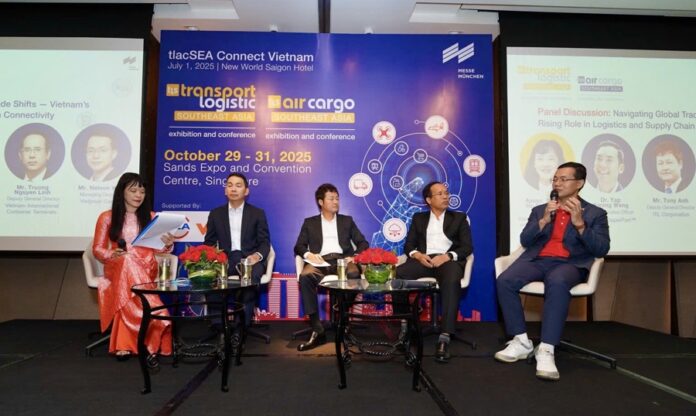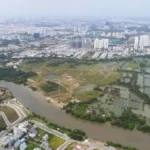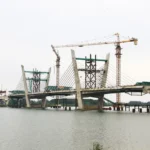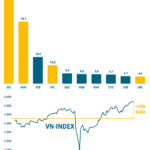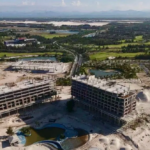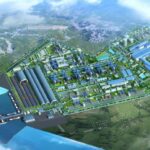At the seminar “Coping with Global Trade Volatility – Vietnam’s Rising Role in Logistics and Supply Chain Connectivity”, experts asserted that from 2012 to now, Vietnam’s GDP has tripled, with FDI pouring into high-tech and e-commerce, reshaping the economic structure. Logistics, once a supporting industry, has become a fast-growing sector, closely linked to exports and investment.
Against this backdrop, developing sea ports, promoting green port models, multimodal logistics, and technology applications are the current focus.
GROWTH BOOSTED BY MACROECONOMIC FOUNDATIONS AND HIGH-TECH FDI
According to Mr. Nelson Wu, Executive Director of Vietjet Air Cargo, Vietnam’s GDP has made a quantum leap in over a decade. From 125 billion USD in 2012, Vietnam’s GDP has now surpassed 470 billion USD, propelling the country to become the fourth-largest economy in Southeast Asia. This breakthrough testifies to Vietnam’s remarkable progress.
Moreover, foreign direct investment (FDI) remains a bright spot, especially in high-tech manufacturing. Giant corporations like Samsung, LG, and Foxconn are expanding their investments, ranging from hundreds of millions to billions of USD, in Bac Ninh, Quang Ninh, Hai Phong, and other northern provinces for electronics and component projects.
Meanwhile, Mr. Tony Anh, Deputy General Director of ITL Corporation and General Director of ITL Aviation Logistics, opined that the North is becoming a high-tech manufacturing hub, while the South remains the focal point for the garment and processing industries.
“FTAs and FDI are considered the backbone driving Vietnam’s industrial integration. With 17 signed FTAs, Vietnam has agreed to open up its domestic market vigorously in exchange for becoming the region’s production and transshipment hub,” said Mr. Tony Anh.
Concurrently, the continuous trade surplus since 2018 reflects the improving production and export capacity, necessitating the logistics system to keep pace with the growth momentum.
Sharing the same view, Mr. Nelson Wu mentioned that the e-commerce boom, with parcel volumes surging from 1.2 million to 8 million per day in just seven years, is exerting immense pressure on the logistics infrastructure, from sea ports to distribution networks.
UPGRADING LOGISTICS HUB STATUS: INFRASTRUCTURE AND STRATEGIC “CATALYSTS”
In the experts’ opinion, the impressive growth stemming from macroeconomic foundations and FDI inflows has given a massive “boost” to the logistics industry. However, behind this development pace are pressing “equations” regarding costs, efficiency, and infrastructure, compelling the entire industry to undergo a significant transformation.
Mr. Nelson Wu stated that in recent years, Vietnam’s logistics growth has been nearly double the GDP growth rate, at about 14% annually. Nevertheless, logistics costs in Vietnam remain at 16-17% of GDP, higher than the ASEAN average of 13%. The main reasons lie in infrastructure bottlenecks and limited multimodal connectivity. Nonetheless, this indicates room for improvement.
A positive signal is that the government is currently ramping up infrastructure investment, with a plan to spend 50 billion USD by 2030. The Long Thanh International Airport project, phase 1, is expected to become operational next year, adding 1.2 million tons of cargo capacity, equivalent to the current total cargo capacity of the Southern region.
Concurrently, pioneers in Vietnam’s port ecosystem are undergoing rapid and professional transformations. According to Mr. Truong Nguyen Linh, Deputy General Director of Vietnam International Container Terminals (VICT), large projects like the Can Gio International Transit Port in the South and Lach Huyen Port in the North are being expanded. Along with collaborations with foreign partners, Vietnam’s port system is gradually forming a large-scale, modern network connected to regional and global transport routes.

From a business perspective, Mr. Truong Nguyen Linh believes that one of the significant orientations today is transforming ports into “green ports” that utilize clean energy, retrofit old equipment, reduce emissions, and obtain ISO certifications for environmental and health standards.
Additionally, due to channel limitations on the Saigon – Vung Tau route, VICT has also considered strategic collaborations and technology investments to maintain its competitiveness. However, the enterprise faces capital investment barriers and lengthy approval processes. “But if we don’t improve promptly, we may lose business opportunities,” VICT’s representative candidly acknowledged.
According to the experts, with a stable macroeconomic foundation, high-quality FDI inflows, and advancements in logistics, Vietnam has the opportunity to emerge as the region’s new production and transshipment hub. By continuously enhancing infrastructure and operational efficiency, Vietnam can break through in the global supply chain in the next decade.
With 14 new industrial parks announced in Q1/2025 and e-commerce growth expected to reach 16-30% annually, Vietnam is continuously expanding its multimodal logistics network. This reinforces its crucial role in the regional supply chain.
In this context, international events such as “Transport Logistic Southeast Asia” and “Air Cargo Southeast Asia” (tlacSEA) aim to foster connections, cooperation, and solution sharing among enterprises in the regional and global supply chains.
The events are expected to take place from October 29 to 31, 2025, in Singapore, with the participation of over 10,000 visitors and more than 300 exhibiting companies in logistics, maritime transport, and aviation. These include leading corporations such as Google, Bosch, Mondelez, Etihad Airways, Qatar Airways Cargo, and Siemens Digital Logistics.
The Coastal Road Connects the East-West Economic Corridor: A Capital Conundrum
The project is envisioned as a vital transportation artery, boosting the economic and social development of Quang Tri Province and the Central region of Vietnam. With its interregional and international connections, it will facilitate trade and improve accessibility, acting as a catalyst for growth and progress in the area.
“VPBank Bids Farewell to Long-Serving Deputy CEO”
Effective July 1, 2025, Mr. Nguyen Thanh Long will step down from his role as Vice President and Head of the Legal and Compliance Control Block at VPBank.

